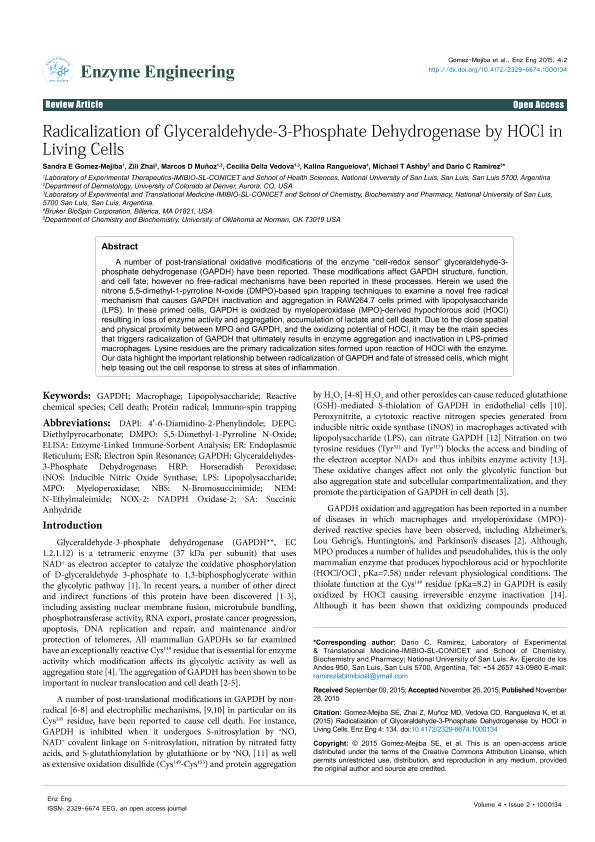Artículo
Radicalization of Glyceraldehyde-3-Phosphate Dehydrogenase by HOCl in Living Cells
Gomez-Mejiba, Sandra Esther ; Zhai, Zili; Muñoz, Marcos David
; Zhai, Zili; Muñoz, Marcos David ; Della Vedova, Maria Cecilia
; Della Vedova, Maria Cecilia ; Ranguelova, Kalina; Ashby, Michael T.; Ramirez, Dario
; Ranguelova, Kalina; Ashby, Michael T.; Ramirez, Dario
 ; Zhai, Zili; Muñoz, Marcos David
; Zhai, Zili; Muñoz, Marcos David ; Della Vedova, Maria Cecilia
; Della Vedova, Maria Cecilia ; Ranguelova, Kalina; Ashby, Michael T.; Ramirez, Dario
; Ranguelova, Kalina; Ashby, Michael T.; Ramirez, Dario
Fecha de publicación:
12/2015
Editorial:
OMICS International
Revista:
Enzyme Engineering
ISSN:
2329-6674
Idioma:
Inglés
Tipo de recurso:
Artículo publicado
Clasificación temática:
Resumen
A number of post-translational oxidative modifications of the enzyme “cell-redox sensor” glyceraldehyde-3- phosphate dehydrogenase (GAPDH) have been reported. These modifications affect GAPDH structure, function, and cell fate; however no free-radical mechanisms have been reported in these processes. Herein we used the nitrone 5,5-dimethyl-1-pyrroline N-oxide (DMPO)-based spin trapping techniques to examine a novel free radical mechanism that causes GAPDH inactivation and aggregation in RAW264.7 cells primed with lipopolysaccharide (LPS). In these primed cells, GAPDH is oxidized by myeloperoxidase (MPO)-derived hypochlorous acid (HOCl) resulting in loss of enzyme activity and aggregation, accumulation of lactate and cell death. Due to the close spatial and physical proximity between MPO and GAPDH, and the oxidizing potential of HOCl, it may be the main species that triggers radicalization of GAPDH that ultimately results in enzyme aggregation and inactivation in LPS-primed macrophages. Lysine residues are the primary radicalization sites formed upon reaction of HOCl with the enzyme. Our data highlight the important relationship between radicalization of GAPDH and fate of stressed cells, which might help teasing out the cell response to stress at sites of inflammation.
Archivos asociados
Licencia
Identificadores
Colecciones
Articulos(IMIBIO-SL)
Articulos de INST. MULTIDICIPLINARIO DE INV. BIO. DE SAN LUIS
Articulos de INST. MULTIDICIPLINARIO DE INV. BIO. DE SAN LUIS
Citación
Gomez-Mejiba, Sandra Esther; Zhai, Zili; Muñoz, Marcos David; Della Vedova, Maria Cecilia; Ranguelova, Kalina; et al.; Radicalization of Glyceraldehyde-3-Phosphate Dehydrogenase by HOCl in Living Cells; OMICS International; Enzyme Engineering; 4; 2; 12-2015; 134-139
Compartir
Altmétricas



